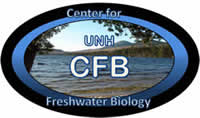Abstract
We examined the physical, chemical and biological properties of York Pond in Coos County Milan, NH as a part of a 6-lake study. Chemical and physical characteristics measured included: total phosphorus and nitrogen, turbidity, light profiles with Secchi disk depth, specific conductivity, oxidation-reduction potential, dissolved oxygen, and temperature. Biological analysis included: phytoplankton percentage, chlorophyll a fluorescence, zooplankton abundance and zooplankton biomass. York Pond had eutrophic levels of several parameters in the epilimnion, including: chlorophyll a (39.4 + 1.04 µgL-1), total phosphorus (46.3 + 0.67 µgL-1), total nitrogen (843.3 + 18.48 µgL-1), turbidity (22.0 + 0.09 NTU), and percentage of cyanobacteria at (42.0 + 9.60 %). Cyanobacteria were even more dominant deeper in the water column, making up more than 70% of the net phytoplankton. The primary source of nutrient loading appears to be effluent from the fish raceways at the Berlin fish hatchery. Eutrophication has shifted the phytoplankton of York Pond toward cyanobacteria, with Anabaena as the dominant genus in the fall. The could have impacts across multiple trophic levels. Comparisons of York Pond to other study lakes suggest that Secchi disk, chlorophyll a and total phosphorus may be useful predictors of cyanobacteria dominance in New England lakes.
Publication Date
1-1-2004
Publisher
UNH Center for Freshwater Biology Research
Document Type
Article
Recommended Citation
Peter, Christopher R., "An ecological assessment of the trophic structure of York Pond in Coos County
Milan, NH" (2004). Center for Freshwater Biology. 9.
https://scholars.unh.edu/cfb/9

